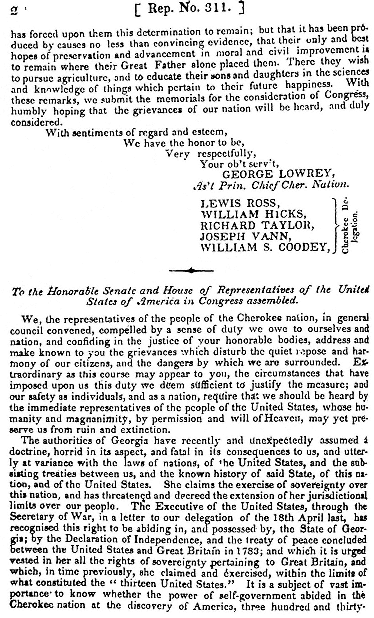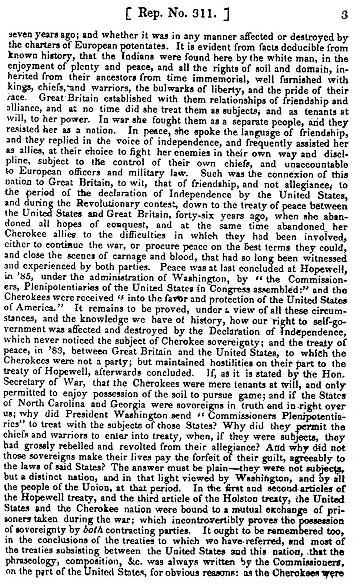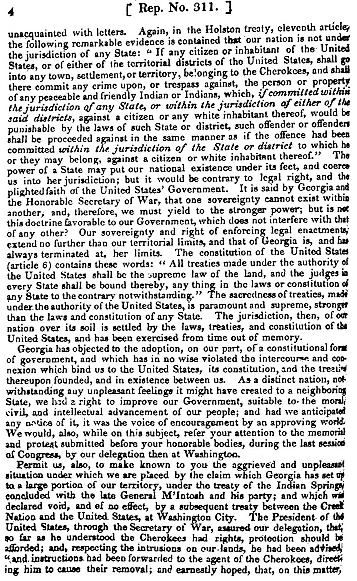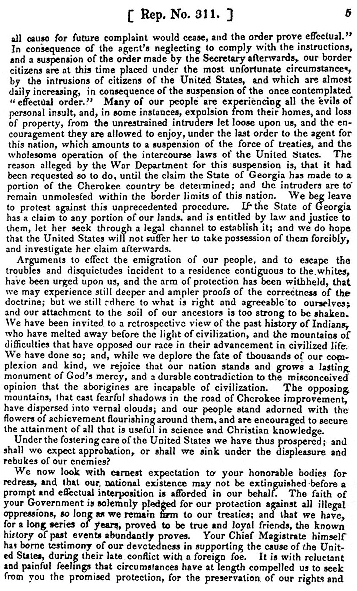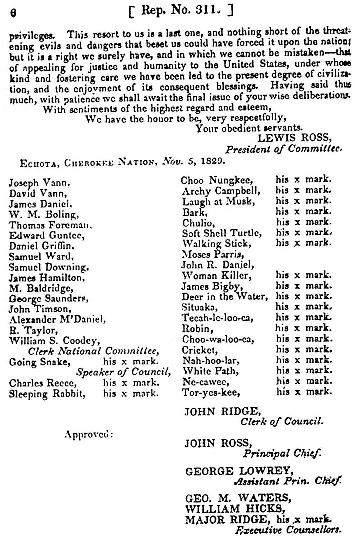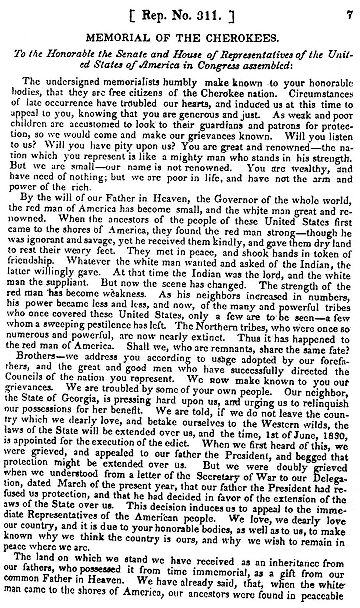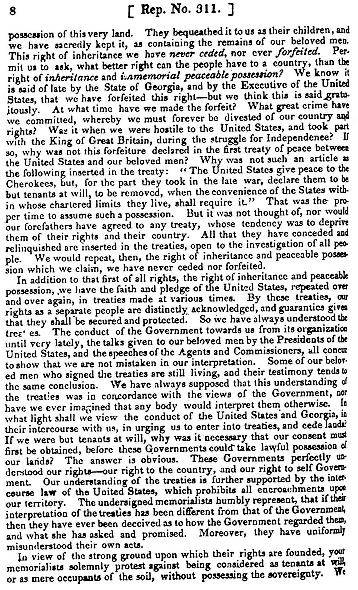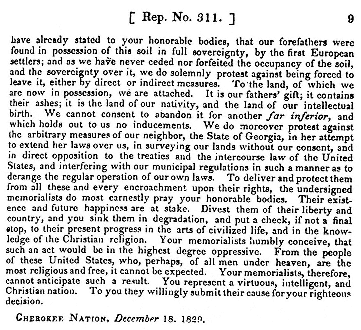5
And yet, having said this much (or little), I must nonetheless confess that in the "official" Memorial of the General Council of the Cherokee Nation to Congress, I don't find anything of substance that I might refer to traditional Cherokee oratorical practices. The majority—twenty-two of the thirty-seven signatories—of the "Memorial" affix an "x mark" rather than a "proper" signature in alphabetic script or in the Sequoyah syllabary to this document, and thus announce themselves as people who do not write. But the "President of Committee," Lewis Ross, the "Clerk of Council," John Ridge, the Principal Chief, Assistant Principal Chief, and two of the three "Executive Counsellors" signing approval of the document do affix their names in script. And these are very likely the men responsible for composing the actual text—one which, as I have said, seems to be in close conformity to American (Western, textual, legal) practice.
To repeat, I find little or nothing in it that would seem to be dependent upon traditional (oral, unlettered) Cherokee practice,[15] but it has not been readily available for study, and I have reproduced it in its entirety in an appendix to this chapter so that any sharper eye or ear than mine may discover what I may have missed. Let me add here that the distance of the Cherokee Memorial from traditional Cherokee oratory, as it seems to me, has—as Eric Cheyfitz has shown in discussions of "Frederick Douglass" in his narrative, and of Caliban in The Tempest —both alienating and liberating potentialities. On the one hand, to accede to the "master's" language, in the Cherokee case, to adopt the prevailing legalistic mode, is to abandon one's own language; on the other hand, to take possession of the master's "books" is to obtain some important part of the master's power—which then, to be sure, may be turned to one's own purposes.
The Memorial of the Cherokee Council opens with what I take to be deliberate although unstated reference to the Declaration of Independence. Jackson had cited the Declaration, in an opinion presented to the Cherokee by the Secretary of War in 1829, as impugning Cherokee rights to their aboriginal homelands, and the Memorial does indeed offer a counterargument to Jackson's on this point later on
[15] This is not the case with the first Memorial from the native citizens of the Nation which employs kinship language—initially that of children speaking to their elders and father(s), then, speaking to "Brothers" (7). There is also in the narrative structure of this document a (mythic?) sense of cycles, it seems to me: of a movement from a height to a low point with the distinctive possibility, phoenix-like, of a rise-again, as the Cherokee memorialists describe their former loftiness in regard to the whites, their subsequent and present lowliness, and their hopes to follow the whites—and here, I would say, the structuring principle shifts—in a progress to civilization and salvation, a progress that would not be likely cyclically to reverse itself.
in the text. But by opening with language that parallels the Declaration's own well-known language, the Cherokee, I believe, seek to substitute metaphorical figures for the ironic, antiphrastic figures (e.g., as noted above, the Indian as opposite and negative of the white man, etc.) regularly employed for the representation of Native people by Jackson, Georgia, and the proponents of removal. The opening words of the Cherokee Memorial, I mean to say, by echoing the language of the Declaration of Independence assert the legitimacy, at least, of political equivalences between the Cherokee and the American colonists. As two peoples who each had, formerly and in the present, to fight for their right to independence, Cherokee and Euramerican may be metaphorically compared rather than antiphrastically contrasted , analogical comparability being the essence of metaphorical figurations.[16]
Addressed, as I have said, "To the Honorable Senate and House of Representatives of the United States of America in Congress assembled" (2), the Cherokee Memorial of 1830 begins:
We, the representatives of the people of the Cherokee nation, in general council convened, compelled by a sense of duty which we owe to ourselves and nation, and confiding in the justice of your honorable bodies, address and make known to you the grievances which disturb the quiet repose and
[16] Both the "Memorial of the Cherokee Council" and that of the native citizens insist upon a history of political equivalence. Both reject the notion that the Cherokee were ever mere tenants at will on their ancestral lands, citing the indisputable fact that both Great Britain and the American government regularly made treaties with them as one sovereign nation with another. The "Memorial of the Cherokee Citizens" also asserts the metaphorical comparability of Cherokee and Euramericans in its notation of the fact that both peoples have known the conditions of largeness and smallness, power and powerlessness.
harmony of our citizens, and the dangers by which we are surrounded. (2)
The Declaration of Independence does not begin this way, of course, for it initially narrates the wrongs done to the colonists by King George. But it then moves to the following words:
We, therefore, the representatives of the United States of America in General Congress assembled, appealing to the supreme judge of the world for the rectitude of our intentions . . .
Where the Declaration first establishes the "long train of abuses and usurpations" for which the British King George III is responsible, the Cherokee Memorial only later establishes some of the abuses not of George but of his namesake state, Georgia. Where the colonists were no longer petitioning George, their principal oppressor, but presenting a "Declaration" to all the world to judge the justice of their case, the Cherokee are decidedly petitioning—not Georgia, their principal oppressor, nor the president, Georgia's staunch supporter, but, rather, petitioning the Congress of the United States, just that body that had adopted the Declaration. (Cf. Thomas Jefferson, "Congress proceeded the same day to consider the Declaration of Independence, which had been reported and lain on the table the Friday preceding, and on Monday referred to a Committee of the whole" [639]—exactly the referee of the Cherokee Memorial.)
Yet in spite of the similarity I have remarked, there is a crucial difference to note as well. For unlike the American colonists who found themselves compelled "in the course
of human events" to declare their independence, the Cherokee find themselves compelled, rather, to affirm theirs. And the Cherokee, I believe, are aware of and mean strategically to exploit the irony that the central, virtually sacred document that had proclaimed the sovereignty of the United States Americans should now be instantiated as the document—so Jackson had claimed—serving to undermine the sovereignty of the indigenous Americans. For "It remains to be proved," the Cherokee Council asserts with a turn to the specifically logical rather than the rhetorical dimension of the issue, "how our right to self-government was affected and destroyed by the Declaration of Independence, which never noticed the subject of Cherokee sovereignty" (3).
Whatever the metaphorical equivalence of Cherokee Indians and American colonists, there is, again, a difference. For, as the Cherokee memorialists write, "It is a subject of vast importance to know whether the power of self-government abided in the Cherokee nation at the discovery of America. . . and whether it was in any manner affected or destroyed by the charters of European potentates" (2–3). And the bulk of the Cherokee Memorial rehearses a history in which both the British colonialists and the American colonists become sovereign (and so free to be imperialists in their turn), consistently treated with those in original possession of the land as independent and (themselves) sovereign nations. That is to say, from the "discovery" of America until the present moment, the representatives of European powers and of the United States treated with the Cherokee metaphorically from a legal and political perspective.
Thus the Cherokee anticipate Jackson's charge in his First Message to Congress that it is intolerable and unconstitu-
tional for any state to allow an Indian tribe "to erect an independent government" (Guttmann and Halsey 38 my emphasis) within its borders. It is the insistence of the Cherokee, supported with a very great deal of (to my mind persuasive) evidence, that they have always been, and have been treated as, an "independent government," a nation sovereign on its own territory. Here again the Cherokee seem fully aware of the irony inherent in the fact that, having recently taken for themselves the specific forms of the American government—having, as they put it, exercised their "right to improve our Government" (4 my emphasis)—they should find that government perceived as an invention, newly erected, rather than as merely a version of what has always been.
In addition to these local, or thematic, ironies, I would suggest that the "official" Cherokee Memorial, from the point of view of emplotment, attempts to replace America's "official" tragic narrative of Indian decline with either an ironic or a comic counternarrative.[17] In figurative terms, to repeat, the Cherokee seek to undo an ironic tropology and to put in its place a metaphorical one; in narrative terms, however, the Cherokee offer to the Congress not the tragic tale it is used to, but instead, a tale that in the light of past
[17] The "Memorial of the Native Citizens" accepts that their story thus far seems to have taken the outline of a Christian tragedy, i.e., that "By the will of our Father in Heaven, the Governor of the whole world, the red man in America has become small, and the white man great and renowned" (7). But they make it quite clear, in the same way as the "Memorial from the Cherokee Council" does, that if they, "who are remnants"—the language, is, as frequently throughout the text, reminiscent of the Old Testament—are to "share the same fate" (7) as the many tribes "now nearly extinct" (7), their story will be marked by injustice and unrighteousness, a cruelly ironic tale. The native citizens, like the Council, conclude with fervent hopes that this will not be their story, although they do not develop the comic prospects in the detail that the Council does, as I note below.
history and present circumstances can only be emplotted ironically or comically.
For the Cherokee Memorial insists that if, indeed, the Cherokee people must remove, they will do so entirely against their will, not voluntarily or by free choice, for "our attachment to the soil of our ancestors is too strong to be shaken" (H. R. 311 5). Thus the Cherokee refuse to accede to the central condition of tragedy, as it is understood by Sophocles or, indeed, by Jackson in his First Message to Congress, refusing a voluntary resignation to their fate. "The power of a State," the Cherokee fully recognize, "may put our national existence under its feet, and coerce us into her jurisdiction; but it would be contrary to legal right, and the plighted faith of the United States' Government" (4). Cherokee removal, as emplotted by the Cherokee , is not the tragic story the whites would tell of the sad-but-just punishment meted out by God, fate, or even the progress of history; instead, the Cherokee insist, the story of their expulsion can be nothing but the story of ironic victimization; should they be removed from their homeland, theirs would be no tragic tale, but rather, the merely pathetic story of people in the wrong place at the wrong time who, despite all their efforts to save themselves, were nonetheless crushed not by right but by might alone. The Cherokee memorialists will not allow their dispossession to be seen, as savagist ideology would have it, as inevitable or necessary, neither God's will, nor Nature's law. Rather, should they be "translated" west of the Mississippi, such an outcome would be the result of no more than the force of American imperial power.
But, of course, the purpose of the Cherokee Memorial in substituting such a bitterly ironic story for the comfortable tragedy familiar to American savagist thought is pre-
cisely to enlist the aid of Congress in preventing that story from taking place. Having announced their firm adherence "to what is right and agreeable to [themselves]," and their strong attachment "to the soil of [their] ancestors" (5), the Cherokee shift to a sketch of a happier outcome than that of removal. Noting that they have "been invited to a retrospective view of the past history of Indians who have melted away before the light of civilization, and the mountains of difficulties that have opposed [their] race in their advancement in civilized life," they yet "rejoice that [their] nation stands and grows a lasting monument of God's mercy, and a durable contradiction to the misconceived opinion that the aborigines are incapable of civilization" (5). As the preceding quotation may already indicate, the Cherokee, as they move toward the conclusion of their Memorial, offer a narrative of identity in which they describe themselves not only as politically analogous to Americans in regard to independence and sovereignty, but as like them in sharing a morally, religiously, and socially progressive future.
The Cherokee delegation writes,
The opposing mountains that cast fearful shadows in the road of Cherokee improvement, have dispersed into vernal clouds; and our people stand adorned with the flowers of achievement flourishing around them, and are encouraged to secure the attainment of all that is useful in science and Christian knowledge. (5)
The florid imagery continues as the Cherokee look to a continuance of "the fostering care of the United States" under which they have "prospered" (5); the latter phrase is repeated as they appeal, in conclusion, "for justice and humanity to the United States, under whose kind and foster-
ing care [they] have been led to the present degree of civilization, and the enjoyment of its consequent blessings" (6). With "patience" the Cherokee await the "final issue of [Congress's] wise deliberations" (6), and, rhetorically at least, propose a comic future in common with the dominant Euramerican society, as each progresses, at its own pace, toward the heights of Christian civilization.
The Cherokee Memorial, as I hope the reader will agree, is a very powerfully persuasive document. Nonetheless, it did not sufficiently persuade the Congress, where, finally, in the House, for want of four votes, as I have already noted, the Indian Removal Act was passed, and the Cherokee committed by law to the ironic destruction they had clearly foreseen and fought to avoid. Subsequent Memorials to Congress did not prevent the extension of Georgia law over the Cherokee in June of 1830, nor their forced removal westward in 1838.

